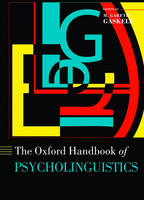
Oxford Handbook of Psycholinguistics
Oxford University Press (Verlag)
978-0-19-856897-1 (ISBN)
- Titel ist leider vergriffen;
keine Neuauflage - Artikel merken
Their contributions are organised into six themed sections, covering word recognition, the mental lexicon, comprehension and discourse, language production, language development, and perspectives on psycholinguistics. The breadth of coverage, coupled with the accessibility of the short chapter format should make the handbook essential reading for both students and researchers in the fields of psychology, linguistics and neuroscience.
PART I - WORD RECOGNITION; 1. Representations and representational specficity in speech perception and spoken word recognition; 2. Audiovisual speech perception and word recogniton; 3. Eight questions about spoken word recognition; 4. Statistical and connnectionist models of speech perception and word recognition; 5. Visual word recognition; 6. Eye movements and visual word recogntion; 7. Speech and spelling interaction: the interdependence of visual and auditory word recognition; 8. Brain processes of word recognition as revealed by neurophysiological imaging; 9. Word recognition in aphasia; PART II - THE MENTAL LEXICON; 10. Representation and processing of lexically ambiguous words; 11. Morphological processes in language comprehension; 12. Semantic representation; 13. Conceptual structure; 14. Connectionist models of reading; 15. The mulitlingual lexicon; 16. The biocognition of the mental lexicon; PART III - COMPREHENSION AND DISCOURSE; 17. Syntactic parsing; 18. Spoken language comprehension: insights from eye movements; 19. Eye movements and on-line comprehension processes; 20. Inference processing in discourse comprehension; 21. Language and action: creating sensible combinations of ideas; 22. Bilingual sentence processing; 23. Event-related brain potential (ERP) studies of sentence processing; 24. Neuroimaging studies of sentence and discourse comprehension; 25. Sentence level deficits in aphasia; PART IV - LANGUAGE PRODUCTION; 26. Alignment in dialogue; 27. Grammatical encoding; 28. Word form retrieval in language production; 29. Speech production; 30. The problem of speech patterns in time; 31. Connectionist principles in theories of speech production; 32. Cross-linguistic research on language production; 33. Brain imaging studies of language production; 34. Language production in aphasia; PART V - LANGUAGE DEVELOPMENT; 35. The perceptual foundations of phonological development; 36. Statistical learning in infant language development; 37. Word learning; 38. Concept formation and language development: count nouns and object kinds; 39. Learning to parse and its implications for language acquisition; 40. Learning to read; 41. Developmental dyslexia; 42. Genetics of language disorders: clinical conditions, phenotypes and genes; PART VI - PERSPECTIVES; 43. The psycholinguistics of signed andspoken languages: how biology affects processing; 44. Spoken language processing by machine; 45. Relating structure and time in linguistics and psycholinguistics; 46. Working memory and language; 47. Language and mirror neurons; 48. The evolution of language: a comparative perspective; 49. Thinking across the boundaries: psycholinguistic perspectives
| Erscheint lt. Verlag | 2.8.2007 |
|---|---|
| Reihe/Serie | Oxford Library of Psychology |
| Zusatzinfo | 67 figures, 5 in colour; 11 black & white photos; 4 page colour plate section |
| Verlagsort | Oxford |
| Sprache | englisch |
| Maße | 171 x 246 mm |
| Gewicht | 1666 g |
| Themenwelt | Geisteswissenschaften ► Sprach- / Literaturwissenschaft ► Sprachwissenschaft |
| ISBN-10 | 0-19-856897-5 / 0198568975 |
| ISBN-13 | 978-0-19-856897-1 / 9780198568971 |
| Zustand | Neuware |
| Haben Sie eine Frage zum Produkt? |
aus dem Bereich


